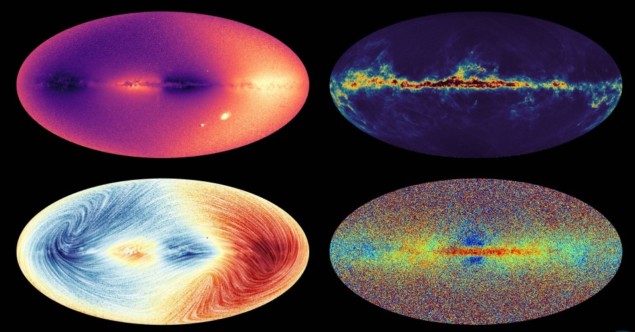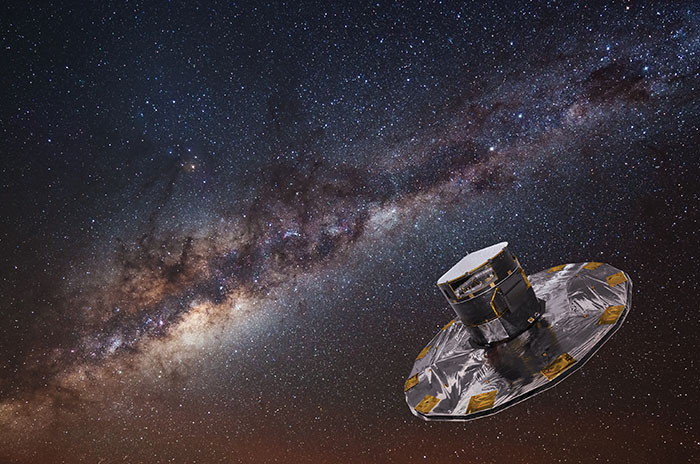Gaia releases most detailed maps of the Milky Way ever taken

The European Space Agency (ESA) has released the latest data from its €450m Gaia mission. It contains information about billions of stars in our Milky Way, a catalogue of thousands of objects in our solar system such as asteroids and moons, as well as data on millions of galaxies and quasars in the universe.
Gaia’s aim is to create the most accurate and complete multi-dimensional map of the Milky Way. This will help astronomers to reconstruct the galaxy’s structure and past evolution over billions of years and to better understand the lifecycle of stars.
Developed by a consortium of 20 countries, Gaia was launched in December 2013 and started observations the following year from its position around 1.5 million kilometres from Earth in the opposite direction from the Sun, a point in space known as L2.
Gaia has two telescopes and the spacecraft rotates once every six hours so that they scan the sky, focusing light onto a huge CCD sensor with nearly a billion pixels – one of the largest ever flown in space.
The first data release, based on just over one year of observations, was published in 2016 and contained the distances and motions of two million stars. That was followed by a second release in 2018 that covered the period between July 2014 and May 2016. This included high-precision measurements of nearly 1.7 billion stars as well as measurements of asteroids within our solar system.
The data will open the floodgates for new discoveriesJosef Aschbacher
An initial release of Gaia’s third data set – which was published in December 2020 – contained high-precision measurements of nearly two billion stars. It allowed astronomers to trace the various populations of older and younger stars out towards the very edge of our galaxy – the so-called “galactic anticentre”.
Today, ESA scientists have released the third data set in its entirety, which includes everything that Gaia has been observing. The catalogue includes new information on the chemical compositions, stellar temperatures, colours, masses, ages, and the speed at which stars move towards or away from us as well as information on 800 000 binary stars, some 155 000 asteroids and millions of galaxies and quasars beyond the Milky Way.
The data release consists of about 10 terabytes of compressed data, making it one of the richest sets of astronomical data ever published.
Stars in their eyes Gaia data release 3 in numbers. (courtesy: ESA/Gaia/DPAC)
Gaia data release 3 in numbers. (courtesy: ESA/Gaia/DPAC)
 Gaia data release 3 in numbers. (courtesy: ESA/Gaia/DPAC)
Gaia data release 3 in numbers. (courtesy: ESA/Gaia/DPAC)One of the surprising findings from the latest Gaia data is that the probe can detect tsunami-like starquakes in hot, massive stars. These are tiny motions on the surface of a star that change their shape. Previously, Gaia had spotted oscillations that caused the stars to swell and shrink while keeping their spherical shape, but it has now seen so-called “nonradial oscillations” in thousands of stars that affect the whole shape of the star.
“Starquakes teach us a lot about stars, notably their internal workings. Gaia is opening a goldmine for ‘asteroseismology’ of massive stars,” says Conny Aerts of KU Leuven in Belgium, who is a member of the Gaia collaboration. She adds that Gaia should be able to detect many more starquakes in future.
Analogous to the 100,000 Genomes project in biology, we are now able to characterize hundreds of millions of starsNicholas Walton
The Gaia data also include the most comprehensive chemical map of the Milky Way ever made. The data show that stars that are closer to the centre and plane of our galaxy are richer in metals than stars at larger distances. Gaia has also detected over 200 candidate exoplanets, with more expected to be discovered by the time the next data set is released.
“It is a fantastic day for astronomy and for ESA,” noted ESA director general Josef Aschbacher at a press conference today. “The data will open the floodgates for new discoveries.” That view is backed up by Günther Hasinger, ESA’s director of science, who adds that Gaia “is turning the world of astronomy upside down”. He adds that the richness of data produce by Gaia is resulting in five papers based on its data being published every day, on average.READ MORE

“This release represents a major step forward in our creation of a detailed census of our Milky Way, fully characterising a significant sample of its stellar constituents,” says Nicholas Walton from the Institute of Astronomy at the University of Cambridge, who is a member of the ESA Gaia science team “Analogous to the 100 000 Genomes project in biology, we are now able to characterize hundreds of millions of stars, which enables us to accurately determine their life cycles from birth to death, and to understand the incredible history and future of our Milky Way.”
A series of scientific papers describing the data will appear in a special issue of Astronomy & Astrophysics.

Michael Banks is news editor of Physics World magazine
from physicsworld.com 18/6/2022
Δεν υπάρχουν σχόλια:
Δημοσίευση σχολίου